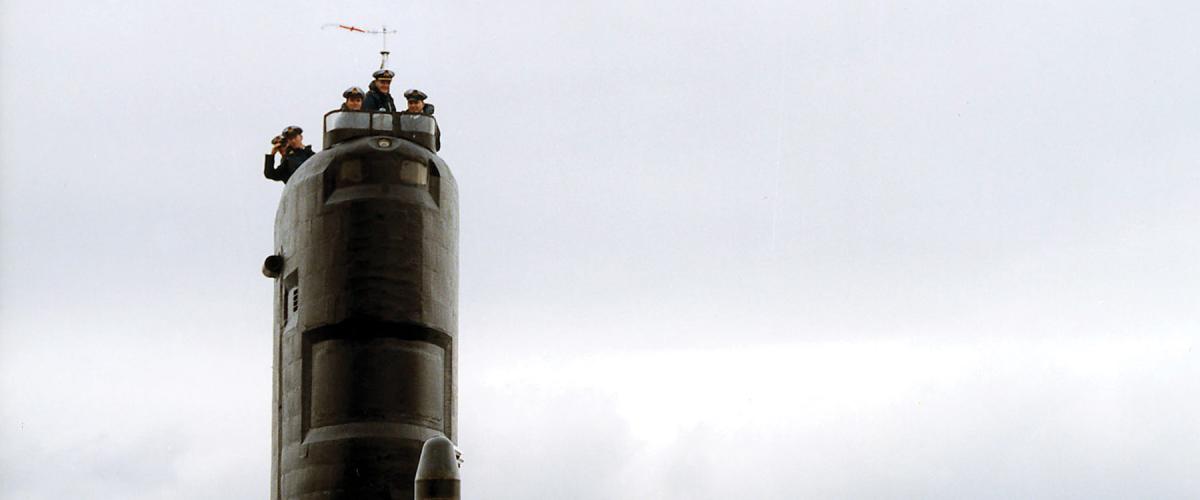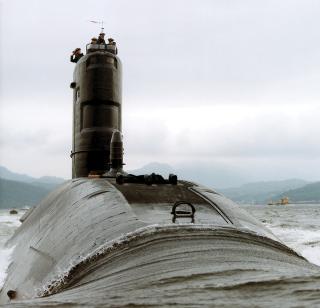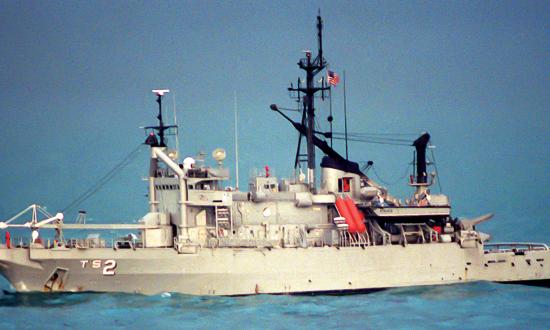Retention Must Be a Special Evolution
The Navy has recently lowered entrance exam requirements in a bid to recruit more sailors. Under the pilot program, the Navy will accept lower scores on the Armed Forces Qualification Test, between the 10th and 30th percentile, provided that the prospective sailor’s Armed Services Vocational Aptitude Battery individual line scores are high enough to qualify for a Navy rating.
It is a mistake to think this a viable option for meeting the Navy’s end-strength manpower requirements.
In the Vietnam Era, Defense Secretary Robert McNamara implemented a similar program of drafting low-IQ recruits. That program didn’t work then, and it won’t work now. Many of those drafted under this program were derisively referred to as “McNamara’s Morons.”
The Navy should look at alternative options. Programs such as this risk dumbing down the workforce and will have an overall detrimental effect on the entire military. We never learn from history.
—YNC Bernard Michael Burawski, USN (Ret.), Life Member
I agree with Lieutenant Swain that to retain the best and brightest sailors, Navy leaders must be mentors and coaches and set proper examples for their subordinates at all times.
When I was a chief petty officer, an operations specialist, I strove to keep my division informed about upcoming projects and our schedule. I welcomed their input and their opinions at our frequent division meetings on how best to accomplish a task.
During in-port time, I sent as many sailors as possible to Navy schools and team trainers to increase in-rate skills. I put them in for awards based on their efforts both at sea and in port. I scoured their service and training records for data I could use in their evaluations to make them more competitive in advancement exams. I didn’t encourage them to get their Enlisted Surface Warfare and Enlisted Aviation Warfare pins until I had already earned mine. However, I never compromised good order and discipline just to curry favor.
I expected a lot from my sailors, but they knew I would fight for them if they needed me to. Back then, chief petty officers were the backbone of the Navy. Restore the authority and leadership of the chiefs, and you will have resolved 90 percent of the retention problem.
—OSC(SW/AW) John M. Duffy, USN (Ret.)
Cyber Power Is a Key Element of Sea Power
Cyber is an essential enabler of every instrument of national power and a vector through which adversaries can affect them all. A nation ineffective in cyberspace cannot succeed in deterrence, competition, crisis, or armed conflict.
Cyber capabilities and operations employed in day-to-day competition have been strategically consequential, rivaling the impact of armed conflict. In large part, this is because U.S. adversaries recognize that cyber capabilities have distinct value for achieving strategic gains in competition without escalating to militarized crisis or worse. They have successfully exploited cyber vulnerabilities to erode the economic competitiveness, military overmatch, and political cohesion of the United States and its allies. The Navy needs to integrate and employ cyber capabilities and operations across the competition continuum.
Commander Bebber rightly calls for naval campaigns that employ cyber power to alter the trajectory of Chinese sea power. Such campaigns require persistence, operating to set the conditions of security and the terms of competition in our favor. This means understanding how adversaries are winning without fighting in and through cyberspace—and then anticipating what vulnerabilities they plan to exploit, how they may do so, and adapting before those vulnerabilities are exploited or weaponized.
Campaigning can undermine the adversary’s desired crisis and war conditions—constraining options, reducing capacity, eroding the adversary’s confidence and trust in its people, capabilities, tactics, and tools, and sowing doubt in its ability to achieve a military fait accompli or prevail in a war of attrition. The goal should be to create an environment that is risky, costly, and futile before crisis and armed conflict through continuous integrated operations in coordination with the interagency, allies, and foreign partners.
National defense has always been more than a matter of deterring or winning in armed conflict. It is also about winning in strategic competition. Accordingly, the joint force has a three-fold task: integrate and leverage cyber power to fight and win across the physical domains of land, air, sea, and space; campaign in and through cyberspace to set favorable conditions to deter in crisis and win in conflict; and persistently campaign in competition where adversaries seek strategic decision outside of armed conflict. Commander Bebber has offered the Navy a way forward to seize and sustain the initiative against our pacing threat. Navy leaders would be wise to consider his counsel.
—Emily Goldman, USCYBERCOM
NATO Navies Must Get the Balance Right
In the “Analysis of Past Naval Operations” section, the authors have made a serious misjudgment that undermines the rest of their thesis. Their assertion that “a Royal Navy victory in the Falkland’s War was not a foregone conclusion” became wrong as soon as HMS Spartan and HMS Conquerer arrived in the South Atlantic.
The presence of submarines, especially nuclear-powered submarines, in a restricted area dooms operations by enemy surface forces. The Baltic is invested with NATO submarines: These forces will establish sea control there early in any conflict—without other forces.
—RADM W. J. Holland, USN (Ret.)
The authors claim that the British Falklands victory was because of “effective British counterfires, made possible by scouting and, again, highly effective [command and control].” However, accounts of those who fought this war (Admiral Sir John Forster “Sandy” Woodward, among others) agree on the following factors for victory:
Strategic—training and competence of Britain’s professional forces, hands-off approach by civilian leaders, matériel support by France and the United States, as well as Wideawake Airfield on Ascension Island and logistics efforts in the UK.
Theater—positioning of carrier battle group and logistics assets.
Tactical—performance of Harriers and their pilots, stamina of troops and tactical acumen of task group commanding officers, training and initiative of naval crews, and extensive use of Special Air Service and Special Boat Service forces.
Contrary to the authors’ claim, command and control were far from ideal. Indeed, command structure during the conflict with three not-quite-equal task group commanding officers (two one-star vs. one two-star officer), communication problems both between Task Forces 317.0 and 317.1 and with CTF 317 back home, as well as subordination of theater submarines to CTG 324.3 instead of to CTG 317.8, were a—if not the—main cause for recurring operational friction.
Finally, had Argentina postponed the invasion until after the decommissioning of the Royal Navy’s two remaining carriers, the Falklands would have become the Malvinas.
—Michael A. Titz, Life member
How to Rebalance the Navy’s Strategic Culture
In many ways, Captain Mobley nails it. In my study of the Navy’s transition to jets, I found that the culture of rugged individualism he describes prevented the adoption of procedures standardization for a decade after Naval Air Systems Command’s safety center determined standardization was the way to operate jets safely. The Navy lost more than a thousand aircraft and aircrew to accidents during that time.
Navy professional military education does need a revamp. When the Naval War College (NWC) was at its most influential, teaching and research (principally via wargaming) were fused, producing both the ideas that would lead to success in World War II and the leaders who executed those ideas. After the war, teaching and research were separated, which remains the case except for the small advanced research programs such as the Halsey Bravo Group.
NWC should reintegrate the two processes at the intermediate level through a classified, technical warfighting curriculum. This would produce new and better warfighting concepts that would enhance NWC’s influence on force development, etc. It also would create a cadre of officers who understand the integrated operation of all elements of a fleet and joint forces.
In 2013, I asked a senior operations analyst how OPNAV N81 integrated strategy documents generated by N5, and he answered that they did not need any external strategy—they developed their own in-house. The culture of numerical analysis locked out qualitative inputs.
—CAPT Robert C. Rubel, USN (Ret.)
You can’t have a maritime strategy without ships. You can’t have ships without mariners. You can’t have ships without shipyards. The naval strategy of the future relies on shipyards, which rely today mostly on Navy or Military Sealift Command gray fleet contracts. We are in a long slow decline. To sustain the shipyards, they must have a reason to exist beyond Navy contracts. This means a healthy U.S. Merchant Marine and commercial fleet.
Foreign fleets are cheaper. If the United States wants a vibrant commercial fleet with mariners who see a future in shipping, then subsidies must be in place. Expansion of current subsidies would be cheap compared with building an aircraft carrier. And it would sustain our shipyards, fleets, and mariners.
—Joseph E. Reynolds
Beyond Force Design 2030: Preparing for Fourth-Generation Combat
I applaud Lieutenant Kim’s continued interest in Marine Corps infantry, and I appreciate his use of military history. His call for cheaper loitering munitions is spot on. On the worrying gap that is small-unit unmanned aerial system (UAS) defense within our battalions, we are in agreement. The means to electronically counter enemy small UASs would be a crucial addition to an infantry battalion’s table of equipment.
His proposed fourth-generation Marine Corps squad is not far from reality already. Platoon commanders and company commanders currently organize and equip their units to best accomplish the mission at hand. The podcast Controversy and Clarity recently interviewed leaders from Alpha Company, 1st Battalion, 2d Marines, one of the Force Design 2030 (FD2030) experimental battalions.
They spoke about employing their squads in formations of two or three fire teams and equipping them to fulfill specific tactical roles in accordance with the commander’s estimate of the situation and in line with the enhanced inventory of weapons and gear from FD2030’s “arms room concept.” Allowing the trained tacticians to man and equip their units for the job at hand negates the need for a one-size-fits-all “fourth-gen squad.”
Saying that specific fire teams will by default perform specific roles limits the tactical flexibility that is a hallmark of Marine Corps infantry. Give company commanders and platoon commanders the tools and the tactical flexibility Marines have employed for generations and they will build the winning teams.
UASs, counter-UASs, and loitering munitions will not completely erase or rewrite the way we layer sensors, fires, and effects to gain an advantage in combat. Combined arms maneuver warfare starts with well-trained and educated tacticians who can make the most of the equipment and personnel within their formations.
—Maj Zach Schwartz, USMC
Update ‘Anchors Aweigh’
Composer-bandleader Charles Zimmerman probably was never on the forecastle when the boatswain’s report that inspired his music was called to the bridge. In fact, few U.S. Navy personnel have ever actually witnessed this operationally and legally significant ritual.
As soon as the anchor is free from the sea floor and hangs freely, the boatswain calls out “Anchor’s aweigh” (not “Anchors aweigh”) to the bridge. At that moment the colors are raised at the mainmast and lowered at the stern; the single black ball signaling that the ship is at anchor is struck; and the jack is lowered at the staff at the bow. The officer of the deck shifts the watch from the quarterdeck to the bridge. At that point, the ship is operationally and legally underway and noted so in the ship’s log.
An apostrophe about the apostrophe: If the lyrics are to be updated to be inclusive, let’s (contraction of “let us”) correct the name of the music, too, to show proper punctuation.
Anchor’s aweigh!
—CDR Earl Higgins, USN (Ret.)
As someone who has loved “Anchors Away” since childhood, I have to respectfully dissent from the suggestion to change the first line from “anchors aweigh, my boys” to “anchors aweigh, sailors.” Lieutenant Commanded McLaughlin’s intent is noble, but his substitute line simply sounds metrically off. I would suggest, instead, “anchors aweigh, all hands” to preserve the meter.
—CAPT Matthew Lim, USN (Ret.)
Reimagine Recruiting to Prevent Sexual Assault
Lieutenant Roland addresses an important topic but mischaracterizes the scope of the problem and offers simplistic, naïve solutions. She contends that “there is more room for [sexual assault] in the Marine Corps than just about anywhere else,” and that only by changing its marketing approach to “recruit better Marines” can it address the problem. To support her thesis, she refers to incidents from decades ago—such as the 1991 Tailhook convention—and presents statistics, such as her comparison of sexual assault rates in the military to the civilian public, that are often misunderstood.
When properly presented, the statistics published in the Uniform Crime Report, the National Crime Victimization Survey, the National Intimate Partner Sexual Violence Survey, and the DOD Workplace and Gender Relations Survey of active-duty members reveal a state of affairs exactly opposite to the dire descriptions offered by Lieutenant Roland.
In an exhaustive 55-page Gonzaga Law Review article (February 2021), “National, Military, and College Reports on Prosecution of Sexual Assaults and Victims’ Rights: Is the Military Actually Safer than Civilian Society?” authors David Schlueter and Lisa Schenck review the data from these national reports, as well as numerous state crime and conviction reports. They conclude that the sexual assault rate for 18- to 24-year-old women in the military is 20 percent lower than the same cohort in college and 35 percent lower than nonstudent civilians. For military men, the rate is less than half that of their college counterparts.
The legal protocols in the Marine Corps require general officer review of all sexual assault charging decisions, dictate the assignment of an attorney to act as a victim advocate (separate from the prosecution or defense), and afford the victim the option of immediate unit reassignment if they so choose. None of these safeguards are available to civilian victims. This unique support structure for victims might help to explain why reporting and conviction rates for sexual assault in the military are five to seven times higher than in all U.S. states with available data. In addition, beyond the legal framework, therapeutic and medical support are also immediately available and can be obtained without making a criminal complaint.
Rather than the Marine Corps being a singularly dangerous environment for the young people who are the majority of potential abuse victims, careful statistical analysis and the basic facts pertaining to sexual assault in the military suggest otherwise. In an era of rising crime and police budget cuts, the Marine Corps and other armed services are significantly safer for their members than civilian alternatives.
—LtCol Shaun T. FitzPatrick, USMC (Ret.)
Assessing Military Capability: More than Just Counting Guns
In the interest of technical accuracy, for which your publication is justly respected, I note that the armored vehicles pictured on p. 27 are not “tanks” but a type of self-propelled gun widely used by Soviet airborne forces in the 1960s: the ASU-85. But “tanks” anyway, for another excellent issue!
—Ben Parker
The Surface Fleet Needs EDOs
Lieutenant Commander Molina presents a good case for making the duties of the ship`s maintenance management officer (SMMO) a primary duty. However, I would question if having an engineering duty officer (EDO) as the SMMO is the best use of these officers.
A warrant officer engineering technician in the SMMO billet would be more efficient. This would still allow the alignment of “experts to tasks” the author advocates while bringing a considerable fund of knowledge to the ship.
—SCPO Paul H. Sayles, USN (Ret.)
A Submariner in Space
Hanging on my wall is one of my proudest possessions, a 1986 letter from Naval Military Personnel Command (NMPC) announcing my nomination for the Astronaut Mission Specialist program. I had just graduated as the only submariner space systems engineer in a Naval Postgraduate School curriculum full of aviators.
My engineering thesis was on the design of a forward-error-correcting code communication system between the yet-to-be-designed space station and astronauts conducting extravehicular activities, compensating for shadow zones created by the station’s truss system. I also wrote a paper that provided lessons from months-long submarine deployments in isolation for long-term missions in space.
NMPC informed me I was the first career nuclear-trained submarine officer ever to be nominated for astronaut—and that my community leaders were none too happy about it. In the end, a problem with my uncorrected visual acuity not meeting astronaut standards kept me out of the program. It’s not an exaggeration to say that was the biggest career disappointment of my life. My thoughts never abandoned the “what ifs” of space.
I’m proud that Captain McCulley, who wore silver dolphins before his career as a naval aviator began, was the first submariner-astronaut. I’m even more proud that one day soon, a gold-dolphin wearing officer, Kayla Barron, may set foot on the moon. I’d like to think that in some small way I established a precedent that the Navy and NASA might be willing to consider that months spent submerged on a submarine was a much more relevant analog for space travel than hours spent in a cockpit.
—CAPT William Toti, USN (Ret.)
Has the Time Come for Midget Submarines?
The first Italian attack against a well-defended harbor was on 1 November 1918. Italian swimmers Rafaelle Paolucci and Rafaelle Rossetti rode a modified torpedo into Pula Harbor and sank the former Austro-Hungarian Vibrus Unitis using limpet mines. The primary difficulty with swimmer delivery vehicles (SDVs) was getting them close enough to their targets. In 1940, Italy lost two fleet submarines trying to deliver SDVs. Finally, in September 1941 SDVs sank three ships around Gibraltar Harbor—supposedly the safest in the world.
World War II German SDVs were hazardous to the operators but were pressed into service against the D-Day landings. At war’s end, the best midget submarine was the German Seehund, with a crew of two. It had a range of 300 nautical miles surfaced or 63 nautical miles submerged at 3 knots. It carried two torpedoes into the English Channel with limited success.
Midget submarines may have use in the Aegean, Bosporus Strait, Black Sea, or the coast of Vietnam in the South China Sea, but there are easier ways to lay mines.
A closer review of midget submarine history is recommended.
—LCDR Sankey Blanton, USN (Ret.)
Asked & Answered
All seven answers published in December highlighted European cemeteries. Did no one submit U.S. military cemeteries in the Pacific?
The Philippines hosts two of the most beautiful and historically significant memorials. The first is the Manila American Cemetery and Memorial, which contains the largest number of graves of our World War II military dead—16,859. It recently underwent a complete renovation, with a new visitor center that depicts the battles fought across the Pacific. I attended the rededication ceremony representing the U.S.-Philippine Society.
The other is the Cabanatuan American Memorial erected by the survivors of the Bataan Death March and the World War II prisoner-of-war camp at Cabanatuan. It honors those Americans and Filipinos who died during their internment. The ABMC took over maintenance of the Memorial in 1989. While serving as a political-military officer in 1992 I had the privilege of attending the 50th anniversary of the Bataan Death March at the Memorial. You could not help but be moved by the absolute cruelty to those who died and the resilience of those who survived.
—CAPT Brian Buzzell, USN (Ret.)







